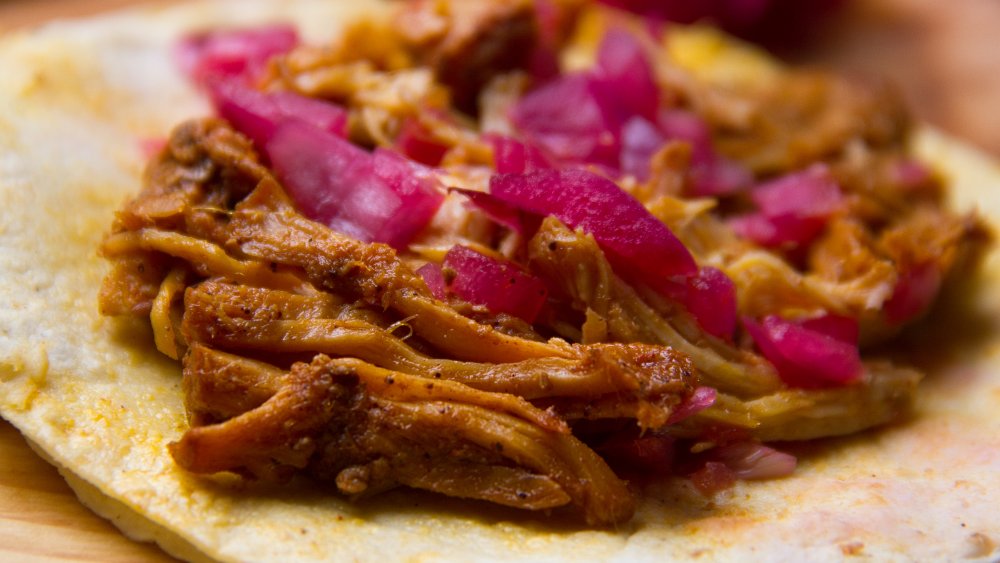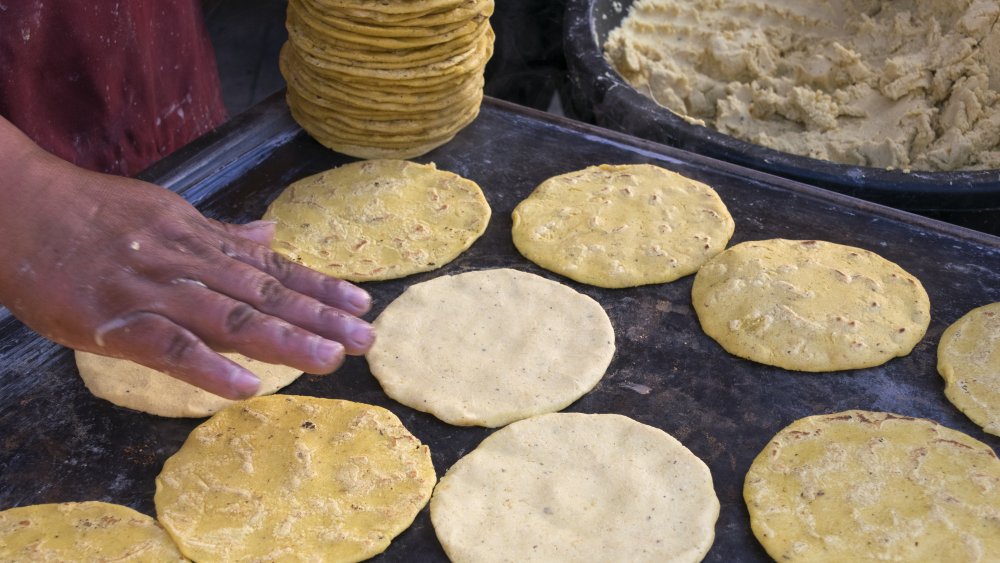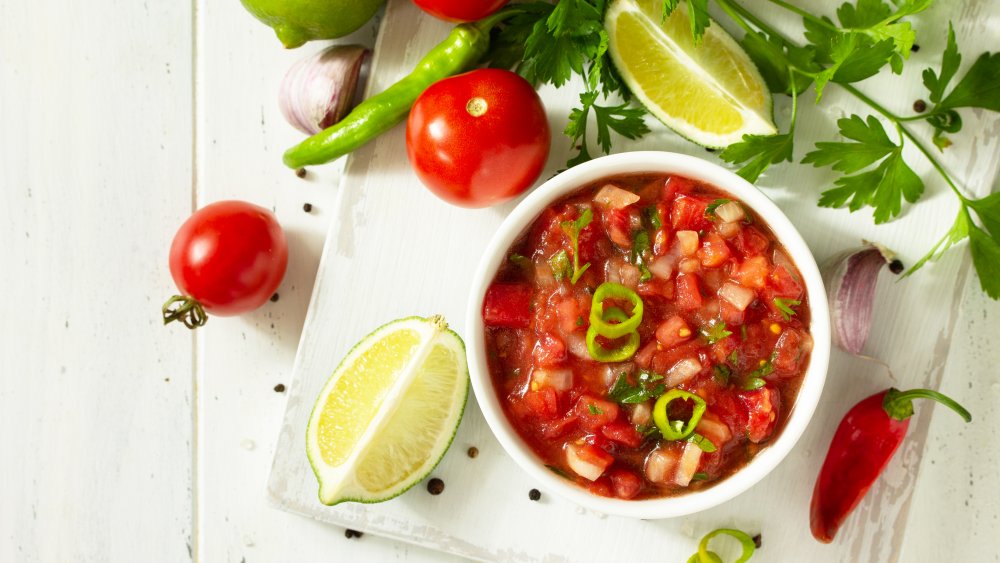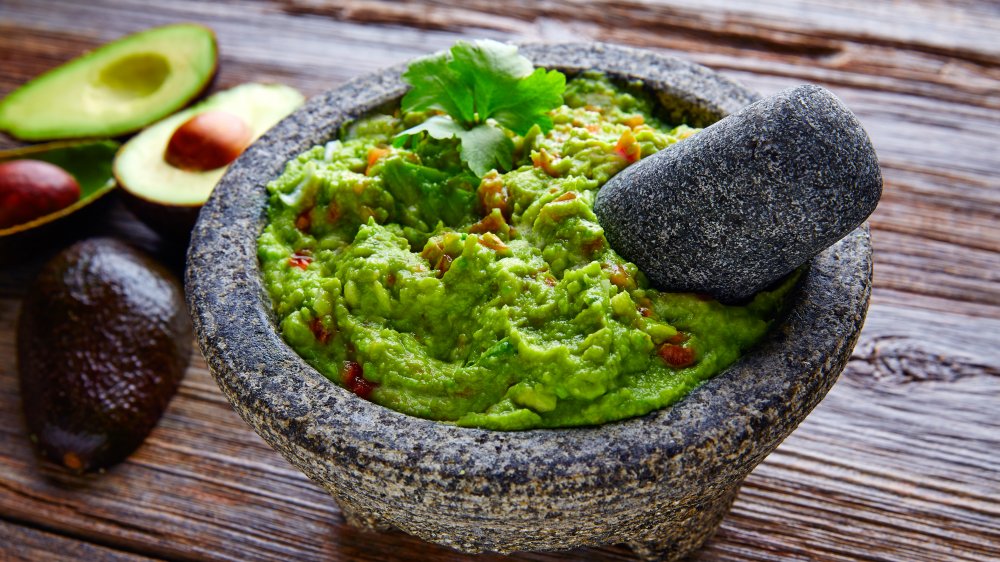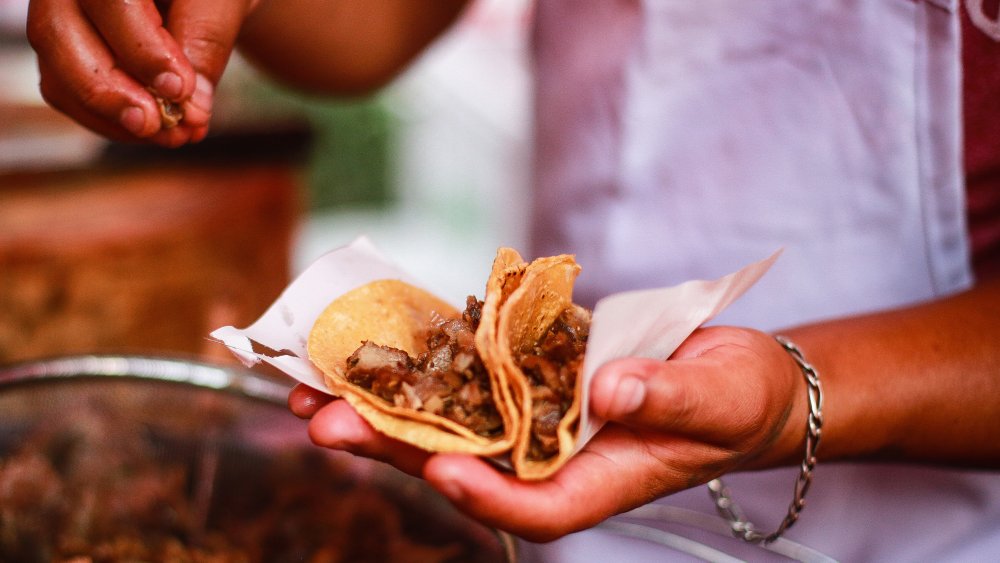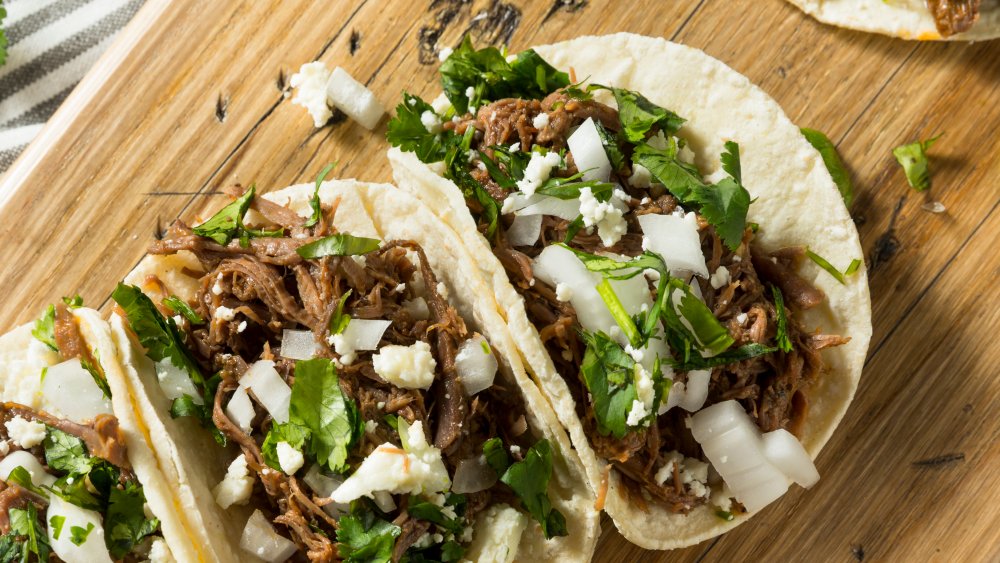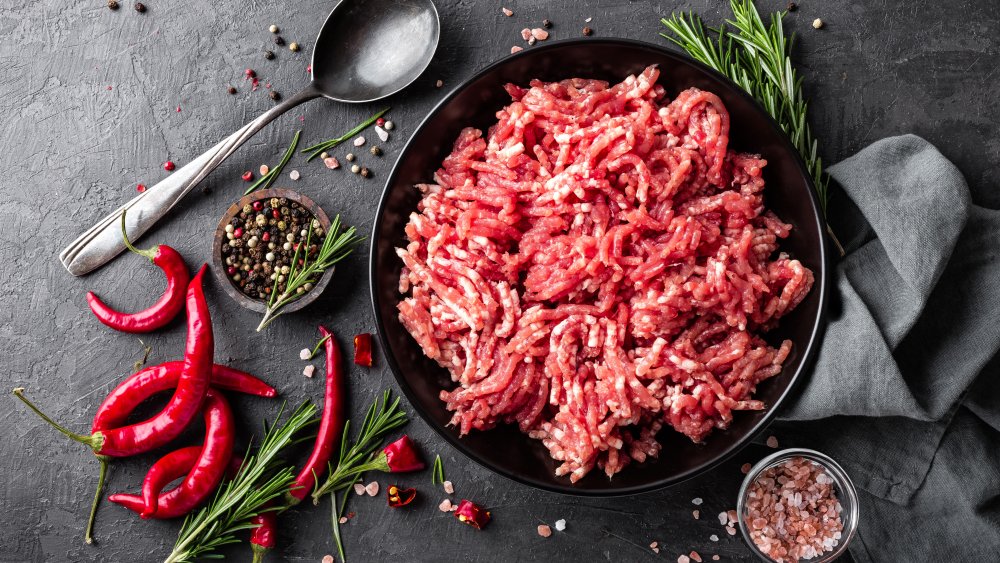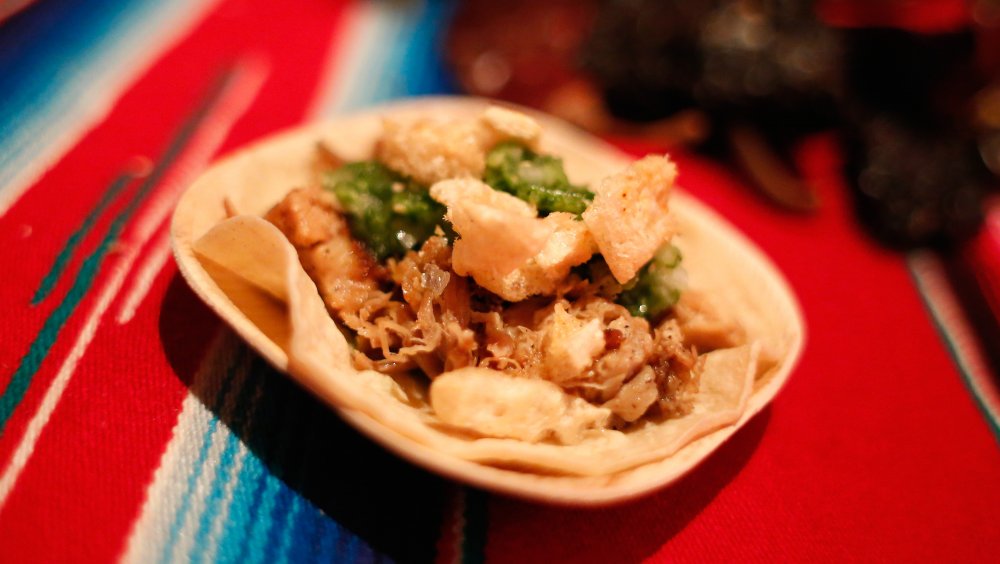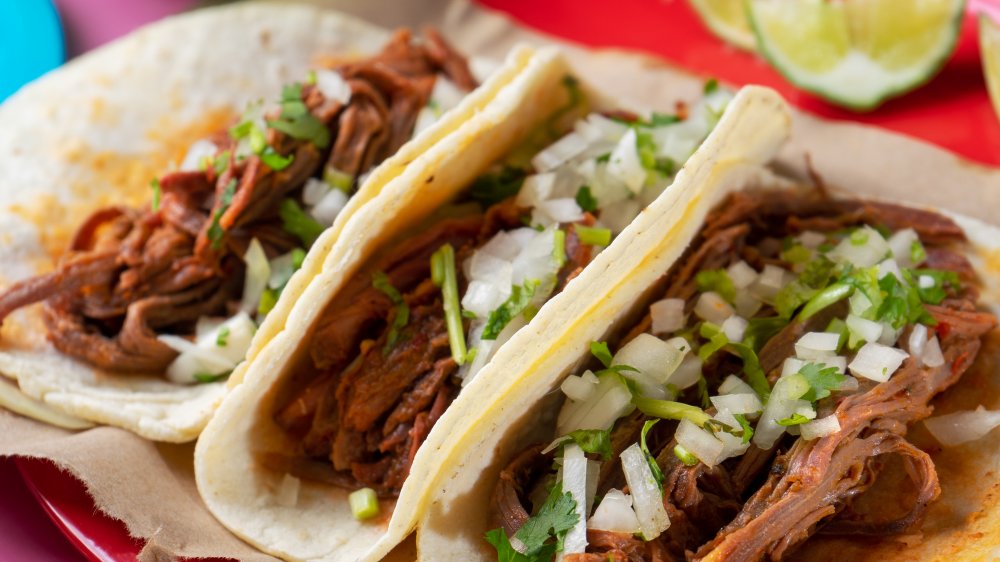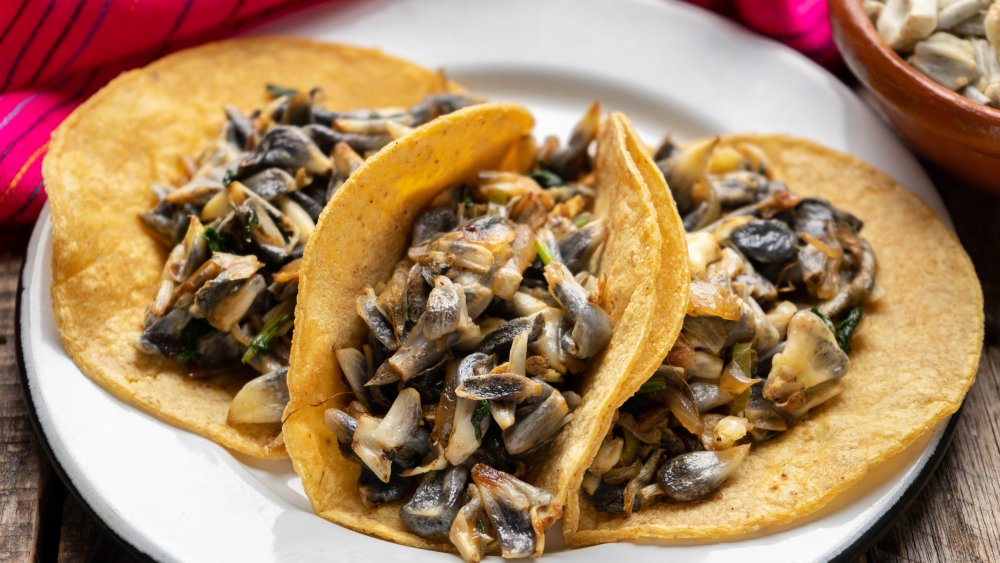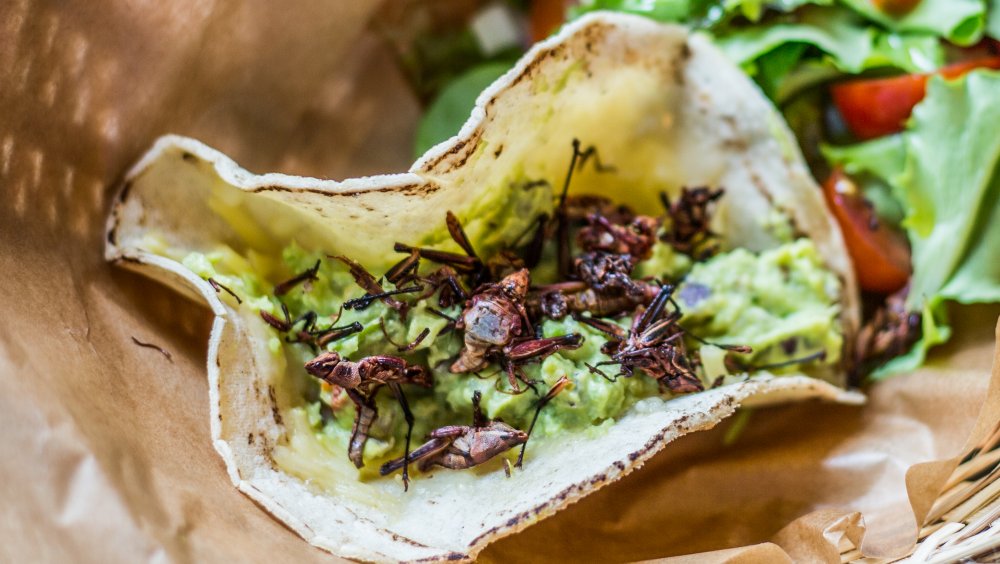How Authentic Tacos Are Different From The American Version
Tacos are so popular in the U.S., you'll find a specialty taco in every state in America, and many of them are pretty close to the real thing you'd chow down in Mexico. But the most common American version that people know is the crunchy hard-shell tortilla crammed with ground beef, tomato, and lettuce, a fistful of yellow cheese, and a large dollop of sour cream. Chef Rick Bayless blames this "near-laughable caricature" as the brainchild of businessmen "... who saw the profits in beans and rice and margaritas" (per Latino Magazine). But he does acknowledge that Mexican-American or Tex-Mex can be just as delicious as authentic Mexican food.
The grande dame of Mexican cuisine, Diana Kennedy, isn't as charitable. She's been writing about authentic Mexican cuisine for years, and she maintains that "people are losing their taste, especially in the U.S., and then it passes to Mexico" (via Vice). Kennedy also believes that young chefs are "... throwing things together that don't really go together. Fancy Southwestern food, Tex-Mex—there are a lot of mismatches" (per Los Angeles Times). The complex history and regional preparations of authentic tacos can actually be studied, as there are both subtle and major differences between an authentic Mexican taco and the American version. It all begins with the tortilla.
Authentic tacos are always made with corn tortillas
Aaron Sanchez feels strongly about hard shells for authentic tacos. "Never do a hard shell," he told Food and Wine. "That's a tostada, not a taco." Since 2005, with the increase of the Mexican population in the U.S., the tortilla market has steadily increased, making it the fastest-growing segment in the baking industry (via Food Business News). Tortillas date back eons when they were made from native ground corn, using a process called "nixtamalization," in which the corn kernels are soaked in quicklime and water for 14 to 18 hours and rinsed several times. The corn is then processed into dough or Nixtamal (via The New Gastronome), which is then hand-shaped or formed in a tortilla press and then cooked on a comal, the traditional Mexican cast-iron griddle.
Nixtamalization increases the nutritional value of the corn and makes its vitamins ready for the human body to digest. But it's time-consuming and labor-intensive, and tortillerías shifted mass production of tortillas using Maseca (or masa) instead. "There are so many tortillerías mixing the corn with Maseca," Diana Kennedy said in an interview with Vice. "And so you've got a whole generation who only know that taste of Maseca." Rick Bayless isn't such a purist, but he does insist that tortillas should be double-stacked to retain their structure (via Wine Spectator). There's another reason for a double tortilla — if any meat falls out, you can use the second tortilla to gather it up.
Authentic tacos have homemade salsa
Culinary anthropologist Diana Kennedy has strong opinions about Mexican cuisine, and in an interview with WFDD public radio, she lectured the interviewer about salsa. "Let's not misuse the word," she said. "Everyone wants to put everything in the world in salsa. It drives me nuts." She insists that salsa is a condiment and not a topping and that it should be made of only four ingredients: chilis, onions, tomatoes, and cilantro. Americans tend to pour bottled salsa over anything as a stand-in for ketchup. But in 2010, then-Oaxaca University student and aspiring chef Javier Olmedo told The New York Times: "Watching someone shovel in salsa with tortilla chips is strange to Mexicans. Like how an American would feel watching someone drink salad dressing out of the bottle."
Salsa is the mainstay of many Mexican kitchens, and when it is used, it's used sparingly, as Vice's Essential Mexico Taco Maps show. The salsa that Kennedy describes is closest to pico de gallo, which translates to "rooster's beak." According to TasteAtlas, the origins of its name remain a mystery, but it is the salsa that is typically found bottled in American grocery stores. Two other sauces are frequently served in authentic tacos in Mexican taquerias: a spicy sauce, often made with habaneros, as Rick Bayless told Wine Spectator, and salsa verde, made with raw or roasted tomatillos. You owe it to yourself to branch out and try the different varieties available.
Authentic tacos are served with a different type of guacamole
Guacamole has become a staple condiment in many regions in the U.S., and you can find it in countless restaurants. But according to Diana Kennedy, we make it all wrong. As she told Christopher Kimball (via 117 Milk Street), authentic guacamole is made from avocadoes, serrano chiles, white onion, and tomatoes. No lime juice, no garlic, no salt, which weren't historically traditional. In Mexico, Kennedy claims, the tomatoes provide the acidic balance to the rich avocadoes, so lime juice isn't needed. Avocadoes are native to Mexico and had been cultivated and eaten by the Aztecs for about 9,000 years (via The New York Times).
Called āhuacatl in Nahuatl, which is a language from indigenous people in Mexico and El Salvador, it translated to "the fruit of the avocado tree" or "testicle" (via Snopes). The word for sauce in Nahuatl is mōlli, so together — āhuacatl-mōlli — means avocado sauce, usually mashed in a molcajete with tomato and chile (per The Austin Chronicle). The Spanish conquistadors couldn't pronounce it, so they changed it to aguacate, which we know as "avocado" in English. The Spanish added onions (per Smithsonian Magazine), and as the sauce's popularity spread, other cultures over have added other ingredients, like cilantro, salt, garlic, and most notoriously. green peas. So Kennedy's addition of onion to guacamole isn't actually Aztec in origin, but it is the most authentic version you could make.
Authentic tacos rarely have shredded cheese
Most Americans know only the Tex-Mex version of tacos and would be shocked to learn that shredded cheese is almost never added to authentic Mexican tacos. For thousands of years, there was no cheese in Aztec food, but then, the Spanish conquistadors introduced cows, goats, and sheep for meat and dairy products, including cheese (via Language and Luxury). If there is cheese on an authentic Mexican taco, it's a mere sprinkling of one of Mexico's many white cheeses — like queso blanco or cotija — and never cheddar or Monterey Jack. According to Eat This, Not That!, even the popular American molten cheese dip queso might provoke an outburst of ¿Qué diablos es eso? from someone who loves authentic Mexican food. According to Delish, a taco with cheese is called a "gringa," a derogatory slang word for a female foreigner.
An exception to the "no cheese" rule is the cheese taco you would find in Vallarta. Per Why Wait to See The World?, this regional specialty is made with a white, milky cheese called panela. So if authentic tacos aren't loaded with cheese, what is used instead? Chopped cilantro and chopped white onion are the usual replacements for cheese (via Rogue Priest) with a spritz of fresh lime, which is always served at a Mexican taqueria.
Authentic tacos have very few toppings
Another major difference between authentic Mexican tacos and American tacos is the toppings. A DIY taco bar is a popular way to feed a crowd, and due to the pandemic, Taco Bell has introduced its own at-home version. Taco Bell's taco kit uses the usual ingredients: tomatoes, lettuce, refried beans, and sour cream. But these standards are only typical of American tacos. According to Rogue Priest, when tomatoes and lettuce make an appearance on a plate of tacos in Mexico, they're considered a salad and not a topping. Raw white onions, cilantro, sliced radish, sliced cucumber, and chili peppers are more typical of authentic tacos in Mexico (per Why Wait to See the World?).
Some tacos have their own special topping, like cochinita pibil, which is traditionally topped with pickled red onion (via Vice). "It is the most emblematic dish of the Yucatán," Rick Bayless told Wine Spectator. "It's always served with pickled red onions and a very explosive habanero salsa." Aaron Sanchez likes adding any pickled vegetable as a topping — from Swiss chard to cactus — which cut through the richness of the meat. There's a practical reason why toppings are minimal in authentic tacos. As Sanchez told Food and Wine: "If you have a six-inch tortilla, then when you take a bite things start falling out. The four-inch tortillas keep everything compact and down to two bites."
Authentic tacos don't have ground beef
This may be disappointing news to the people planning their regular Taco Tuesday, but there is no ground beef in authentic tacos. "That's no bueno," Aaron Sanchez told Food and Wine. If you're staring down at a plate of hard-shell tacos with ground beef, you're probably at Taco Bell or some other "whack Tex-Mex place," says Cosmopolitan. There are several types of popular beef tacos, but other meats are used as well, and, as mapped by Vice, different regions and states in Mexico have their own specialty tacos.
In Jalisco, you would find a taco de birria, which is goat or sheep that's been cooked in broth and spices (and sometimes in a hole in the ground) and then shredded. Another favorite is tacos de cabrito, which you would find in Nuevo Leon (per Vice's taco map, part 2). This traditional dish, which Mexico inherited from converted Sephardic Jews, uses baby goat meat that's been slowly roasted. One of the most famous authentic tacos is tacos al pastor, which actually hails from Lebanon. It's essentially shawarma or slow-roasted lamb that's roasted on a vertical skewer and carved. There are so many meats used in authentic tacos, you'll never go back to ground beef again.
Any part of the pig is in authentic tacos
Search online for "carnitas," and you'll find hundreds of authentic taco recipes. You've probably seen this dish at countless Mexican restaurants you've been to. Authentic carnitas are made from fatty pork shoulder and are a specialty of the state of Michoacán, where the pork is simmered in lard, usually in a large copper pot (per Food52). However, you can find regional preparations of carnitas throughout Mexico that are simmered in different liquids, such as chicken broth, orange juice, and Coca-Cola (via Focus on Mexico). In Jalisco, carnitas isn't just pork meat — it's also prepared with lamb, veal, or other types of meat, so cooks can really get creative with what they make.
Pig, though, is the traditional meat, and in Mexico, cooks follow the nose-to-tail philosophy so that no part of the pig is wasted. According to Vice, when ordering carnitas in Mexico, you need to be very specific about what you want, or you'll find some pig innards thrown in. Maciza — the lean parts of the leg and shoulder — has almost no fat and not as much flavor as other cuts of pork. One of the porkiest tasting tidbits is the stomach, and if you're feeling adventurous, you could have a taco with the tail, the snout, a foot, guts, and any internal organ, or a combination of them. To really enjoy an authentic carnitas taco, it's clear you'll need swallow your fear and go whole hog.
Authentic tacos have only two or three ingredients
One of the misconceptions about tacos is they need to be loaded up with meat, beans, rice, and too many toppings. But most authentic tacos usually have two or three ingredients. According to Smithsonian Magazine, it's theorized that the word "taco" referred to the explosive powder charges that Mexican silver miners used in the 1700s to excavate silver ore. In an interview with Bespoke Post, Jeffery Pilcher, Ph.D., author and professor of Mexican and Latin American Culture, claims that "the miners started calling their lunches tacos as well, since tortillas wrapped around potatoes or other simple stuffings with hot sauce resembled the little sticks of dynamite."
Tacos were originally working class food in Mexico City, and with industrialization, countryside women who couldn't find factory work in the city used their cooking skills and sold tacos on the street. Tacos were meant to be a cheap, portable meal for workers (per OZY) and were kept simple. Although there are regional variations, the recipe is essentially the same: meat or fish and a couple of garnishes or sauce, wrapped in a fresh corn tortilla. Some combinations are traditional, like carne asada with chili sauce, carnitas with pineapple, and fish with shredded cabbage and guacamole. Today's non-traditional tacos might not meet Diana Kennedy's purist approach, but as she was quoted by The Kansas City Star: "A soft tortilla rolled around, or two small ones doubled over, and practically any type of filling constitutes a taco."
Authentic tacos can have corn fungus
One of the most treasured and delicious ingredients for an authentic Mexican taco is what's known as corn smut or huitlacoche. Huitlacoche is a parasitic fungus that blooms inside of growing corn during rainy season and can completely engulf the kernels (per Texas Monthly), turning them into silvery, bulbous blossoms. Long considered a scourge by American corn farmers, Mexican families would walk miles to gather ears of corn infected with this distant relative of the mushroom (via NPR). Diana Kennedy wrote in her book The Cuisines of Mexico that huitlacoche has "... an inky, mushroomy flavor that is almost impossible to describe."
Huitlacoche is packed with protein, fiber, and the amino acid lysine, and it may have been consumed by Mexico's indigenous people. According to The Mexicanist, although there is no archeological evidence that the Aztecs ate huitlacoche, in the 19th century when Mexico was going through social upheaval and food was scarce, the lower classes sought it out, and until recently, it has been associated with poverty.
Today, however, it's considered a delicacy, especially in France, where it's called "Aztec caviar." Huitlacoche hasn't quite caught on in the U.S., but it is increasingly finding its way onto menus of restaurants with adventurous chefs (via The Washington Post). But it's a staple in Mexican markets and can be purchased fresh or canned, or you can sample a huitlacoche taco or quesadilla yourself at most market stalls in Mexico City (via Culture Trip).
You might find edible bugs in an authentic taco
The Aztec diet was mostly vegetarian — with the exception of insects (per Experience Mayahuel). That ancestral tradition lives on today. The Washington Post reported that insect-eating was regarded with disgust by upper-class Mexicans, but today, the markets are overflowing with the tasty creepy crawlies. One seller shrugs off the criticism: "We ate them because we were hungry." One of the most cherished edible insects is escamoles — ant larvae — which are carefully harvested from the ant nests so as not to disturb the colony (via Explore Parts Unknown). When fried in butter, escamoles resemble corn kernels with a nutty taste. They're usually served in an authentic taco with guacamole (per Eat Your World).
Another yummy bug is the maguey worm, which often finds its death in the bottom of a bottle of mezcal. The maguey is actually a caterpillar, and when fried, some people say they taste like pork cracklings (reported by Random Times) and are eaten as a taco filling. In Oaxaca, grasshoppers or chapulines are gathered during the rainy season, deep-fried and seasoned with chili and lime, and piled into tortillas with salsa and guacamole (via Atlas Obscura). Although crunching down and swallowing their legs and wings can take some getting used to, chapulines are described as tasting like salt-and-vinegar potato chips "(but wetter)." All of these insects are packed with protein, so if you want to eat like a local, fill your tacos with bugs.
